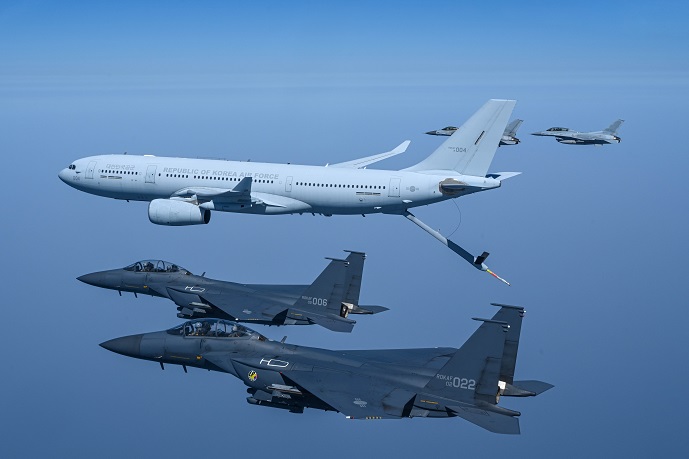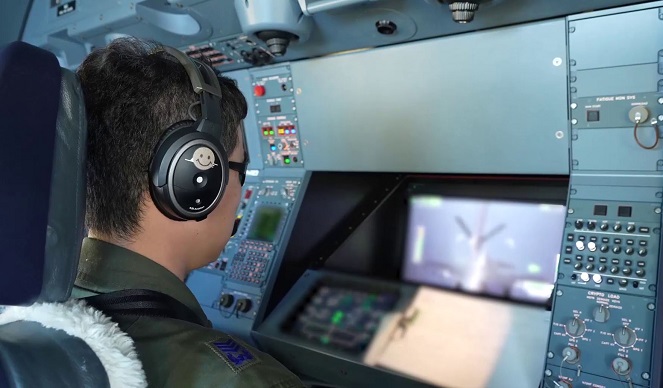
A KC-330 tanker transport aircraft and fighter jets engage in an aerial refueling operation over the Yellow Sea on April 13, 2023, in this photo provided by the South Korean Air Force.
SEOUL, April 13 (Korea Bizwire) — After getting a 20-minute prior notice for this week’s aerial refueling mission, South Korean Air Force crewmembers aboard a KC-330 tanker transport aircraft shifted into full standby mode to conduct their familiar yet delicate tasks.
Twenty minutes later, the pilot and refueling control personnel worked seamlessly through a raft of sensitive procedures, including extending a boom to a receiver aircraft flying near the tanker plane over the Yellow Sea on Wednesday.
The defense ministry’s press corps was given rare access to the operation, which highlighted the Air Force’s steady pursuit of air preeminence on the Korean Peninsula amid growing North Korean military threats.
Outside the window, F-15K and KF-16 fighters came into view, waiting for a fuel injection.
An F-15K jet flew close to the KC-330 plane and put itself into a position secure enough to stably receive fuel. The refueling work proceeded as the planes traveled at a speed of 530 kph or more at an altitude of around 4,500 meters.
Sitting behind the pilot, refueling control staff looked at three-dimensional imagery to control the entire process — an undertaking that requires high-level skills, without which officials said a misstep could arise to damage the exterior of the receiver plane.
During Wednesday’s mission, the KC-330 conducted the refueling of four planes in a combined time of 40 minutes.
Throughout it, the reporters did not experience any of the serious vibrations that could have occurred had things not proceeded smoothly.
Usually a team of five or six personnel work together for such a refueling operation.

An Air Force crewmember carries out an in-flight refueling mission aboard a KC-330 tanker transport aircraft on April 13, 2023, in this photo released by the South Korean Air Force.
“Pilots are always under pressure to check the remainder of their fuel, but the refueling tanker has enabled them to maximize their individual capabilities and those of their planes, free from the burden of ensuring enough is left in their fuel tank,” Squadron Commander Lt. Col. Cho Ju-young said.
He added, “Through stable operational management and realistic training, we will establish an around-the-clock readiness posture for decisive combat.”
The Air Force currently operates four KC-330 planes. The tanker fleet has so far conducted around 7,400 refueling operations since the first KC-330 was deployed here in January 2019.
Its deployment has significantly increased the duration of fighter jet operations.
Before its rollout, an F-15K jet was able to operate over the country’s easternmost islets of Dokdo and Ieodo, a submerged rock south of the southern island of Jeju, only for 30 minutes and 20 minutes, respectively.
But now, the duration of their operations has increased “dramatically,” the Air Force said.
The KC-330 can also carry up to 300 people or 37 tons of cargo, a reason why it has been used for various missions, including humanitarian operations.
The aircraft participated in the transportation of COVID-19 vaccines in 2021, and the evacuation of Afghan colleagues from their war-ravaged country that same year, among other missions.
(Yonhap)






